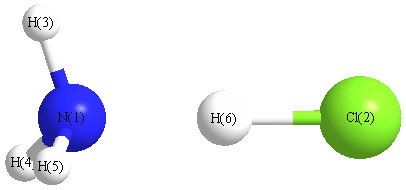Vibrational Frequencies calculated at wB97X-D/aug-cc-pVTZ
| Mode Number |
Symmetry |
Frequency
(cm-1) |
Scaled Frequency
(cm-1) |
IR Intensities
(km mol-1) |
Raman Act
(Å4/u) |
Dep P |
Dep U |
|---|
| 1 |
A1 |
3513 |
3361 |
0.25 |
|
|
|
| 2 |
A1 |
2120 |
2028 |
2241.63 |
|
|
|
| 3 |
A1 |
1107 |
1059 |
138.68 |
|
|
|
| 4 |
A1 |
184 |
176 |
42.84 |
|
|
|
| 5 |
E |
3642 |
3484 |
19.12 |
|
|
|
| 5 |
E |
3642 |
3484 |
19.17 |
|
|
|
| 6 |
E |
1663 |
1591 |
22.93 |
|
|
|
| 6 |
E |
1663 |
1591 |
22.98 |
|
|
|
| 7 |
E |
816 |
780 |
31.58 |
|
|
|
| 7 |
E |
816 |
780 |
31.58 |
|
|
|
| 8 |
E |
237 |
227 |
13.17 |
|
|
|
| 8 |
E |
237 |
227 |
13.18 |
|
|
|
Unscaled Zero Point Vibrational Energy (zpe) 9819.8 cm
-1
Scaled (by 0.9566) Zero Point Vibrational Energy (zpe) 9393.6 cm
-1
See section
III.C.1 List or set vibrational scaling factors
to change the scale factors used here.
See section
III.C.2
Calculate a vibrational scaling factor for a given set of molecules
to determine the least squares best scaling factor.
Charges, Dipole, Quadrupole and Polarizability
Charges from optimized geometry at wB97X-D/aug-cc-pVTZ
Charges (e)
| Number |
Element |
Mulliken |
CHELPG |
AIM |
ESP |
| 1 |
N |
-0.150 |
|
|
|
| 2 |
Cl |
-0.369 |
|
|
|
| 3 |
H |
0.078 |
|
|
|
| 4 |
H |
0.078 |
|
|
|
| 5 |
H |
0.078 |
|
|
|
| 6 |
H |
0.283 |
|
|
|
Electric dipole moments
Electric dipole components in Debye
(What's a Debye? See section
VII.A.3)
| |
x |
y |
z |
Total |
| |
0.000 |
0.000 |
-4.693 |
4.693 |
| CHELPG |
|
|
|
|
| AIM |
|
|
|
|
| ESP |
|
|
|
|
Electric Quadrupole moment
Quadrupole components in D Å
| Primitive |
|---|
| | x | y | z |
|---|
| x |
-20.235 |
0.000 |
0.000 |
| y |
0.000 |
-20.235 |
0.000 |
| z |
0.000 |
0.000 |
-15.387 |
|
| Traceless |
|---|
| | x | y | z |
|---|
| x |
-2.424 |
0.000 |
0.000 |
| y |
0.000 |
-2.424 |
0.000 |
| z |
0.000 |
0.000 |
4.847 |
|
| Polar |
|---|
| 3z2-r2 | 9.695 |
|---|
| x2-y2 | 0.000 |
|---|
| xy | 0.000 |
|---|
| xz | 0.000 |
|---|
| yz | 0.000 |
|---|
|
Polarizabilities
Components of the polarizability tensor.
Units are
Å
3 (Angstrom cubed)
Change units.
| |
x |
y |
z |
| x |
4.312 |
0.000 |
0.000 |
| y |
0.000 |
4.312 |
0.000 |
| z |
0.000 |
0.000 |
6.469 |
<r2> (average value of r
2) Å
2
| <r2> |
78.184 |
| (<r2>)1/2 |
8.842 |
